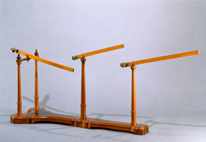
35.4 x 25.2 x 71
Carved and engraved wood and brass
INDEX 1788 : E.II.125
Vectis ex tribus vectibus compositus.
A lever composed of three levers.
's Gravesande describes this machine in his work entitled Physices Elementa. The machine is a set of three interfixed levers, the smaller arms of each being of equal length. The bigger arms are of different lengths, and are divided into four, five and six equal parts. The middle lever is the shortest and is divided into five segments. Each one of the levers can exert a force on its immediate neighbour. These levers are mounted on three columns that are erected on a common wooden base.
The three levers must be mounted in such a manner that the end of the bigger arm of the lever with six divisions remains supported on the end of the smaller arm of the intermediate lever of the set. In turn, the end of the bigger arm of this lever exerts a force on the end of the smaller arm of the longest lever. Thus, the apparatus described by 's Gravesande had the multiplying capacity of 5 x 4 x 6 = 120. That is, if a body whose weight is 120 units is suspended from the end of the smaller arm of the lever divided into five segments, the system will stay in equilibrium if a body whose weight is just one unit is suspended at the end of the last division of the bigger arm of the biggest lever.
A beautiful brass weight with the inscription 125 belongs to this set of equipment.
From Colégio dos Nobres, catalogue n.º 117.
's Gravesande, Willem Jacob, Physices Elementa, Leiden, 1742, § 296, Tab. XI, Fig. 1.